
Landscaping fabric, also known as garden fabric or weed barrier fabric, is a versatile and essential tool in modern gardening and landscaping. It is typically made from woven or non-woven synthetic materials that allow water and air to pass through while blocking sunlight. This unique attribute makes it an excellent choice for a variety of gardening tasks.
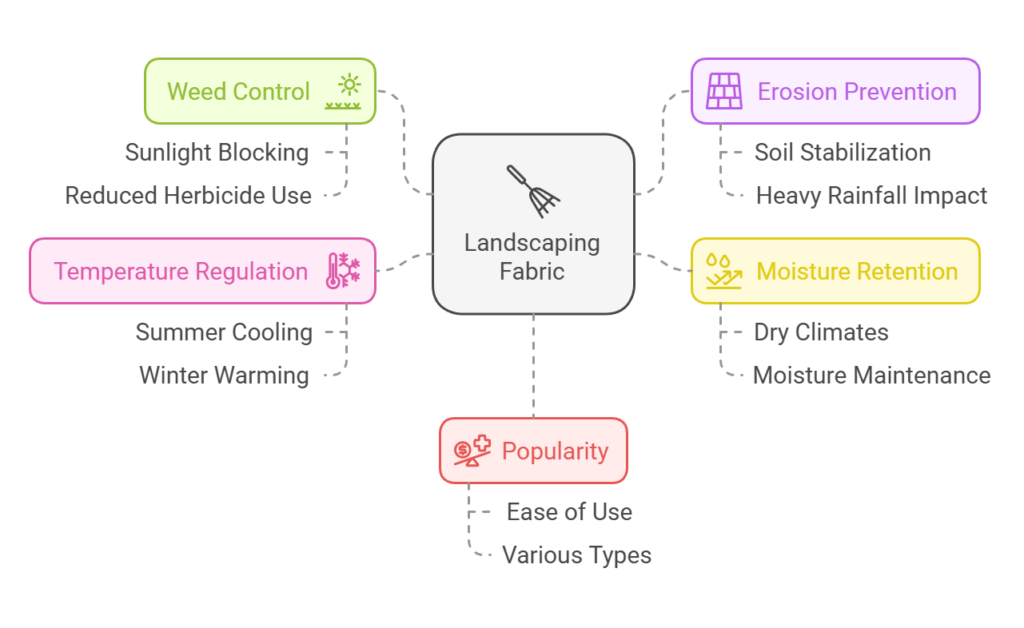
The primary purpose of landscaping fabric is to control weeds. By preventing sunlight from reaching the soil, it inhibits the growth of unwanted plants, thereby reducing the need for chemical herbicides. This makes it an eco-friendly option for maintaining a neat and tidy garden. Additionally, landscaping fabric helps in soil erosion prevention by stabilizing the soil and reducing the impact of heavy rainfall. This is particularly beneficial in sloped areas where soil displacement can be a significant issue.
Landscaping fabric is also commonly used in flower beds, vegetable gardens, and around trees and shrubs. Gardeners and landscapers appreciate its ability to maintain soil moisture by reducing evaporation, which is critical in dry climates. Furthermore, it aids in temperature regulation by providing a barrier that can keep the soil cooler in the summer and warmer in the winter.
The popularity of landscaping fabric has surged in recent years due to its effectiveness and ease of use. It is a cost-effective solution that saves time and labor in garden maintenance. Many types of landscaping fabric are available, each designed to meet specific needs, from heavy-duty options for high-traffic areas to lightweight varieties for less demanding applications. As a result, it has become a go-to choice for both amateur gardeners and professional landscapers seeking to enhance the beauty and health of their outdoor spaces.
Landscaping fabric is an essential tool in modern gardening and landscaping, offering a variety of options to meet different needs. The primary types of landscaping fabric include woven, non-woven, and spun-bound fabrics, each with unique characteristics, advantages, and disadvantages.
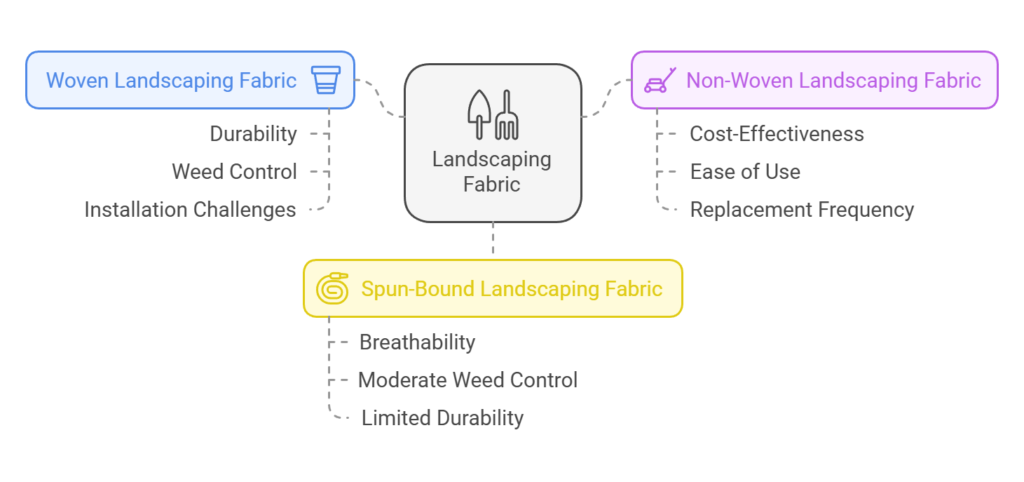
Woven Landscaping Fabric: Woven fabrics are made from tightly interwoven polypropylene or polyester threads. This type of fabric is highly durable and provides excellent strength, making it suitable for high-traffic areas. Woven fabrics are particularly effective at preventing weed growth while allowing water, air, and nutrients to pass through. However, they can be more expensive than other types and require careful installation to avoid fraying.
Non-Woven Landscaping Fabric: Non-woven fabrics are made from bonded fibers, typically through a heat or chemical process. These fabrics are often more affordable and easier to cut than woven ones. They offer good weed control and are ideal for areas where heavy mulching is used. However, non-woven fabrics may not be as durable as their woven counterparts and might need replacement more frequently, especially in high-stress environments.
Spun-Bound Landscaping Fabric: Spun-bound fabrics are created by bonding long strands of synthetic fibers together. This type of fabric is known for its lightweight and breathability, making it suitable for delicate planting areas where airflow and moisture control are crucial. Spun-bound fabrics offer moderate weed control and are less invasive than other types. On the downside, they might not provide the same level of durability and strength as woven fabrics, making them less suitable for heavy-duty applications.
Choosing the right type of landscaping fabric depends on the specific requirements of your project. Woven fabrics are excellent for high-durability needs, non-woven fabrics are cost-effective and easy to use, and spun-bound fabrics provide superior breathability for sensitive plantings. Understanding these options ensures that you can select the most appropriate fabric to enhance the effectiveness and longevity of your landscaping efforts.
Landscaping fabric offers a multitude of benefits that can significantly enhance garden and landscape projects. One of the primary advantages is effective weed suppression. By acting as a barrier, landscaping fabric prevents weed seeds from germinating and growing through the soil, thus reducing the need for chemical herbicides and making garden maintenance more manageable. This not only saves time but also contributes to a healthier environment.
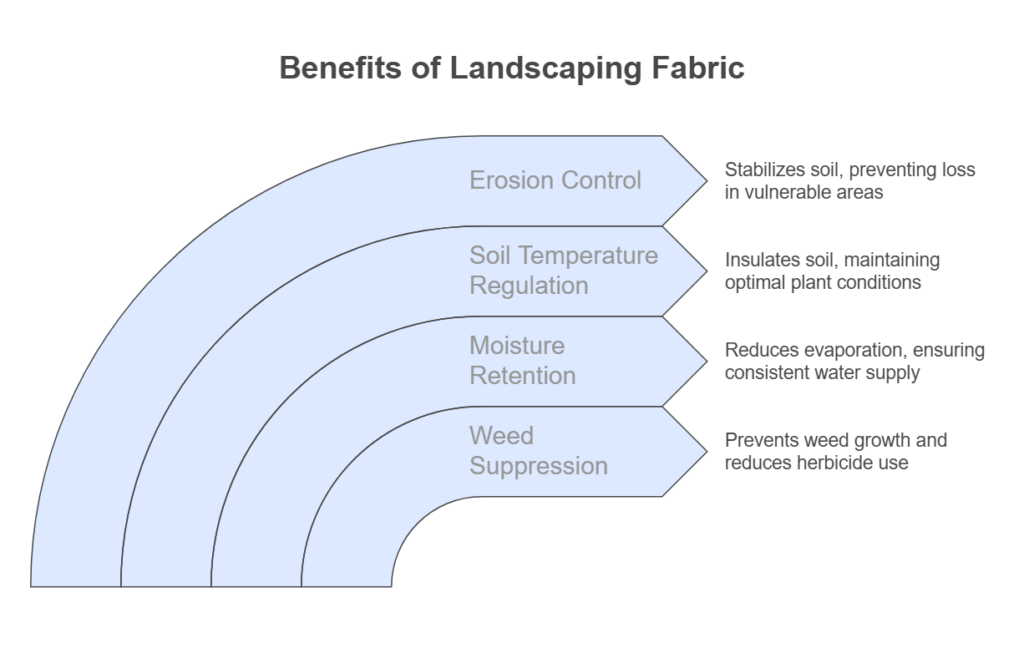
Another notable benefit is moisture retention. Landscaping fabric helps to retain soil moisture by reducing evaporation. This is particularly beneficial during dry spells or in arid climates, as it ensures that plants receive a consistent supply of water. Consequently, gardeners can reduce the frequency of watering, leading to water conservation and healthier plant growth. For instance, using landscaping fabric in a vegetable garden can result in more robust and productive plants.
Soil temperature regulation is another key advantage. Landscaping fabric acts as an insulating layer, moderating soil temperatures by keeping it cooler in the summer and warmer in the winter. This can be crucial for temperature-sensitive plants, enabling them to thrive despite fluctuations in weather conditions. For example, in a flower bed, landscaping fabric can help prevent the roots from overheating during hot summer days.
Moreover, landscaping fabric plays a vital role in erosion control. It stabilizes the soil by preventing it from being washed away during heavy rains or irrigation. This is particularly important on slopes or in areas prone to erosion. By securing the soil, landscaping fabric helps maintain the integrity of the landscape, ensuring that plants have a stable and fertile ground to grow. For instance, using landscaping fabric on a hillside can prevent soil erosion and protect the roots of newly planted shrubs.
Overall, the use of landscaping fabric can lead to healthier, more manageable, and sustainable gardens and landscapes. By leveraging its benefits, gardeners can achieve a balance between aesthetic appeal and environmental stewardship.
Proper installation of landscaping fabric is essential to maximize its effectiveness in weed control and soil protection. Below is a comprehensive step-by-step guide on how to install landscaping fabric correctly.

Tools and Materials:
Before starting, gather the necessary tools and materials: landscaping fabric, utility knife or scissors, garden staples or landscape fabric pins, a measuring tape, and a rake.
Site Preparation:
Begin by preparing the site where the landscaping fabric will be installed. Clear the area of any existing weeds, rocks, and debris. Use a rake to level the soil surface, ensuring it is smooth and even. This step is crucial as a clean and level base will help the fabric lie flat and perform optimally.
Fabric Placement:
Unroll the landscaping fabric over the prepared area. Measure and cut the fabric to fit the dimensions of your site. For larger areas, you may need to overlap multiple sheets of fabric by at least 6 inches to prevent weeds from growing through the seams. Make sure the fabric is placed with the rough side facing down to improve grip on the soil.
Securing the Fabric:
Once the fabric is in place, secure it to the ground using garden staples or landscape fabric pins. Insert the staples every 12 to 18 inches along the edges and across the fabric. This will prevent the fabric from shifting and ensure it remains taut against the soil.
Cutting and Fitting Around Plants and Obstacles:
For existing plants, cut an “X” shape in the fabric and fold back the flaps to position the fabric around the base of the plant. For new plantings, make a small slit or hole in the fabric to insert the plant. When fitting the fabric around obstacles such as trees or shrubs, cut the fabric as needed and secure the edges with additional garden staples.
Proper installation of landscaping fabric is key to its performance. Taking the time to prepare the site, placing the fabric accurately, and securing it effectively will result in a durable and functional weed barrier that enhances the health and appearance of your landscaping.
When implementing landscaping fabric, several common mistakes can undermine its effectiveness and longevity. One frequent error is improper installation. Ensuring the fabric is laid out smoothly and securely is crucial; wrinkles and folds can compromise its functionality and aesthetic appeal. To avoid this, take the time to carefully lay the fabric flat and secure it with landscape staples every few feet. This will prevent shifting and maintain its barrier properties.
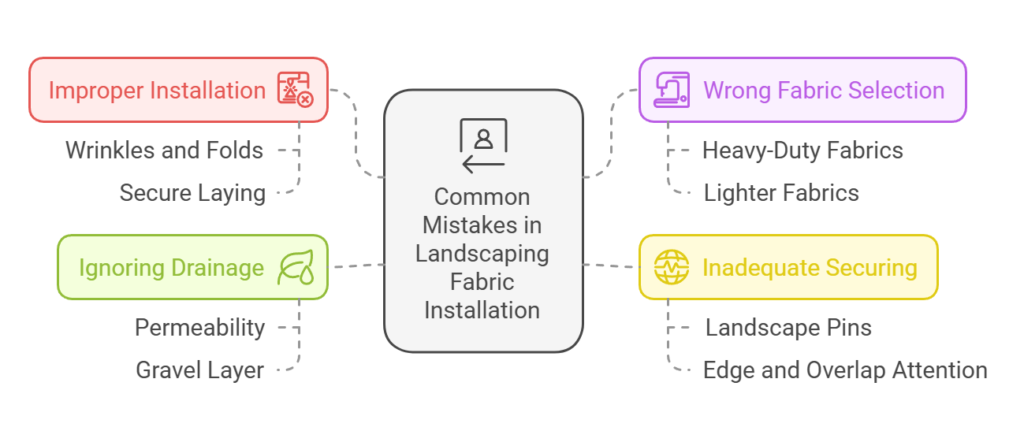
Another common mistake is selecting the wrong type of fabric for your specific needs. Landscaping fabrics vary in thickness and permeability, and using the incorrect type can lead to poor results. For instance, heavy-duty fabrics are ideal for areas with high foot traffic or where robust weed control is necessary, while lighter fabrics are suitable for garden beds with lighter plantings. Assess the specific requirements of your project and choose accordingly to ensure optimal performance.
Neglecting to properly secure the fabric is another pitfall. Inadequate anchoring can result in the fabric being dislodged by wind, water, or foot traffic. Use landscape pins or staples to firmly anchor the fabric to the ground, paying extra attention to the edges and overlaps to prevent any gaps that could allow weeds to penetrate.
Additionally, ignoring the importance of proper drainage can lead to water pooling and subsequent plant health issues. Landscaping fabric should be permeable enough to allow water to pass through while still blocking weeds. If water cannot drain effectively, it can cause root rot or other moisture-related problems. Ensure the fabric you select allows for adequate water flow and consider installing a gravel layer beneath the fabric to facilitate better drainage.
By being aware of these common mistakes and following these best practices, you can maximize the benefits of landscaping fabric and achieve a more successful, long-lasting landscaping project.
Proper maintenance of landscaping fabric is essential to ensure its longevity and effectiveness in controlling weeds and promoting a healthy garden environment. Regular inspection and timely repairs play a pivotal role in achieving this goal. To maintain the fabric, start by conducting periodic checks, especially after significant weather events. Look for any signs of wear and tear, such as holes, tears, or areas where the fabric has been displaced.
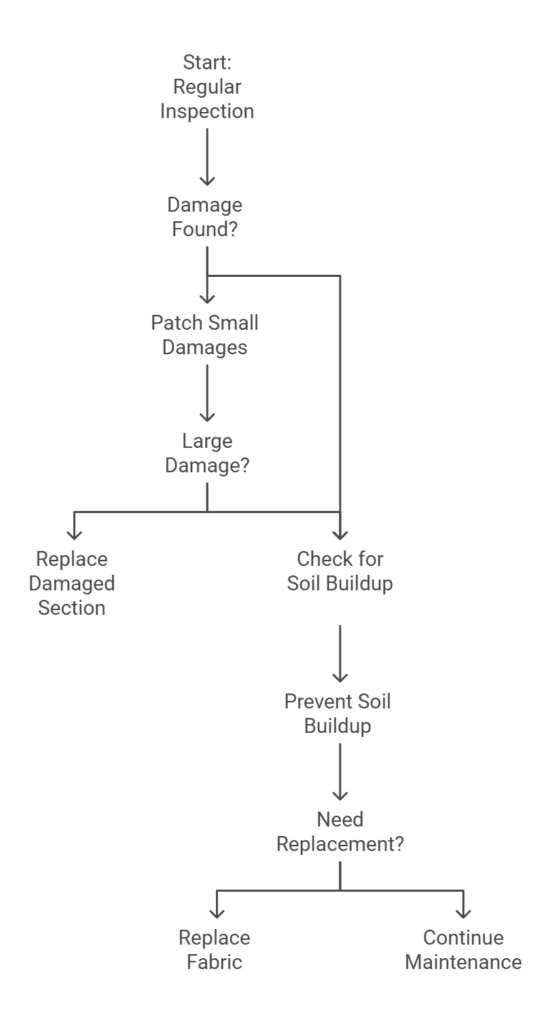
When damage is identified, swift action is necessary. Small tears or holes can be patched using fabric adhesive or by sewing a piece of new fabric over the damaged area. This not only prevents weeds from penetrating through the gaps but also extends the overall lifespan of the landscaping fabric. For larger damaged sections, consider cutting out the affected area and replacing it with a new piece of fabric, securing it with landscape pins or staples to ensure it stays in place.
Another critical aspect of maintaining landscaping fabric is preventing soil and mulch buildup on top of the fabric. Excessive buildup can lead to the fabric becoming less effective at weed control. Regularly rake and redistribute mulch to avoid compaction and ensure proper aeration. This also helps in maintaining the aesthetic appeal of your garden.
Despite diligent maintenance, there will come a time when landscaping fabric needs to be replaced. Signs that it’s time for replacement include widespread damage, significant wear, and reduced effectiveness in weed control. The process of replacing the fabric involves carefully removing the old fabric, ensuring that no remnants are left behind, and then laying down new fabric following the original installation guidelines. This includes overlapping edges and securing the fabric properly.
To extend the lifespan of landscaping fabric, consider using high-quality, UV-resistant materials. Additionally, applying a thick layer of mulch on top of the fabric can protect it from direct sunlight and physical damage. With regular maintenance, timely repairs, and proper replacement practices, landscaping fabric can provide years of effective weed control and contribute to a healthy and vibrant garden.
Landscaping fabric, often referred to as weed control fabric, is a popular choice for garden and landscape maintenance. However, it is not the only option available for controlling weeds and managing soil. Alternative methods such as mulch, plastic sheeting, and natural ground covers offer varying advantages and disadvantages, making them suitable for different applications.
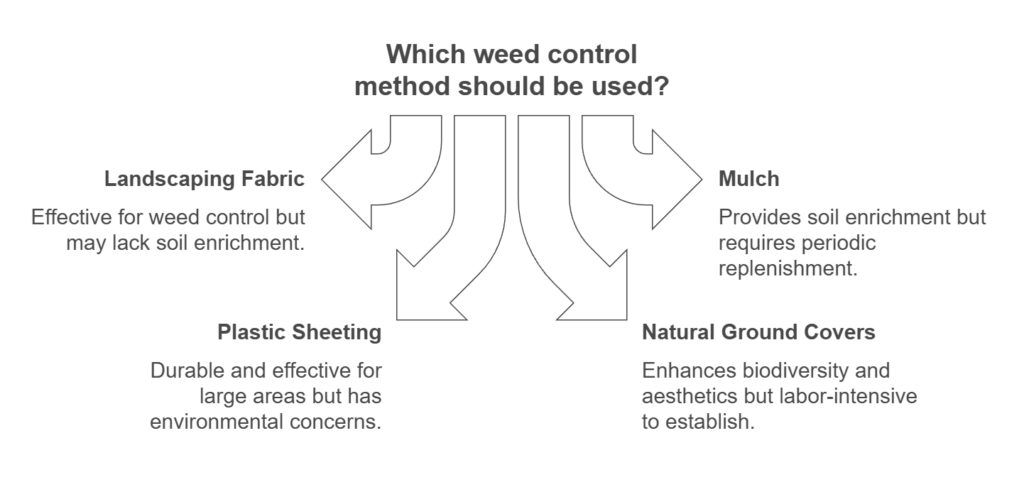
Mulch, for instance, serves as both a weed barrier and a soil conditioner. Organic mulches like wood chips, straw, and compost enrich the soil as they decompose, providing essential nutrients to plants. This natural process enhances soil fertility and water retention. However, it requires periodic replenishment as it breaks down over time. In contrast, inorganic mulches such as gravel and stone do not decompose, offering a more permanent solution but lacking the soil-enriching benefits of organic options.
Plastic sheeting is another alternative, particularly effective for large-scale weed control and moisture retention. It is durable and can completely block sunlight, thereby inhibiting weed growth. However, it can also interfere with water and air movement in the soil, potentially harming plant roots. Additionally, plastic sheeting is not biodegradable, raising environmental concerns. It is often best used in specific scenarios, such as under gravel paths or in areas where long-term weed suppression is critical.
Natural ground covers, including plants like clover, thyme, and creeping phlox, offer a living alternative to landscaping fabric. These plants can outcompete weeds, reduce soil erosion, and enhance the aesthetic appeal of a landscape. They also contribute to biodiversity, providing habitat for beneficial insects and wildlife. However, establishing ground covers can be labor-intensive and may take time to become effective in weed suppression. They are best suited for areas where a permanent, low-maintenance solution is desired.
Each of these alternatives presents unique benefits and drawbacks, making them suitable for different landscaping needs. When choosing a method, it is essential to consider factors such as the specific requirements of the plants, the long-term maintenance involved, and environmental impact. By understanding the advantages and limitations of landscaping fabric and its alternatives, one can make an informed decision tailored to their specific landscaping goals.
In conclusion, landscaping fabric serves as a versatile tool that can significantly enhance the efficacy and aesthetics of your gardening projects. By effectively controlling weed growth, conserving soil moisture, and reducing the need for chemical interventions, landscaping fabric proves to be an indispensable asset for both novice and experienced gardeners.
Throughout this guide, we have delved into various aspects of landscaping fabric, from its types and benefits to the essential steps for proper installation. Understanding the specific needs of your garden is crucial in selecting the right type of fabric, whether it be woven, non-woven, or perforated options. Each type caters to different requirements, ensuring that your plants thrive while minimizing maintenance efforts.
Proper installation is key to maximizing the benefits of landscaping fabric. Ensuring thorough ground preparation, secure anchoring, and appropriate mulching will extend the lifespan of the fabric and enhance its effectiveness. Regular checks and maintenance will further ensure that the fabric continues to perform optimally, providing long-lasting results.
We encourage you to assess your gardening goals and consider how landscaping fabric can align with your specific needs. Whether you aim to establish a weed-free vegetable garden, maintain a pristine landscape, or create a low-maintenance flower bed, the right choice of fabric can make a significant difference.
As you embark on your landscaping projects, remember that patience and careful planning are essential. While landscaping fabric offers numerous advantages, combining it with other best gardening practices will yield the best results. Stay committed to your vision, and don’t hesitate to experiment with different techniques to discover what works best for your garden.
With the right knowledge and tools, successful landscaping is within your reach. Utilize the insights from this guide to make informed decisions and enjoy the myriad benefits that landscaping fabric can bring to your outdoor spaces.

We will contact you within 1 working day, please pay attention to the email with the suffix “@non-woven.com”.
11 Responses
Fantastic site A lot of helpful info here Im sending it to some buddies ans additionally sharing in delicious And naturally thanks on your sweat
Tech to Trick Very well presented. Every quote was awesome and thanks for sharing the content. Keep sharing and keep motivating others.
Thanks for your kind words! Glad you liked it. Will keep sharing.
Tech to Force This is really interesting, You’re a very skilled blogger. I’ve joined your feed and look forward to seeking more of your magnificent post. Also, I’ve shared your site in my social networks!
Thanks for your compliment! Glad you liked the post. We’ll try to bring more valuable content like this.
Mat6tube Incredibly informative articles and reviews at the moment
Thank you so much for your kind words! We’re thrilled that you find our articles and reviews on http://www.non – woven.com incredibly informative. Your feedback means a lot to us, and we’ll keep striving to provide high – quality content for you.
Your article helped me a lot, is there any more related content? Thanks!
We’re glad to hear that our article was helpful to you! There’s plenty more related content on our website. You can explore our “Articles” section, where you’ll find in – depth pieces on non – woven materials, manufacturing processes, and applications. If you have specific topics in mind, feel free to let us know, and we’ll do our best to point you in the right direction.
Your article helped me a lot, is there any more related content? Thanks!
Glad to hear that our article was helpful to you! We do have more related content. You can explore other sections on our website, such as the blog archives or category pages. There, you’ll find in – depth articles, case studies, and industry insights. If you have any specific topics you’d like us to cover, feel free to let us know.